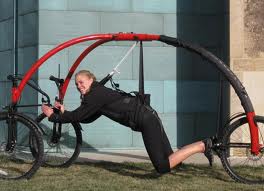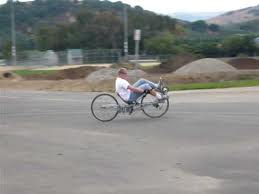When I’m out riding my Montague, the bike sometimes attracts a little bit of attention. People want to know about the double top tube, see how the bike folds, and how the quick release levers work. But a lot of the time, no one really notices.
If you want a bike that really attracts attention though, check out these:
This looks a little bit like the sport of skeleton, which you see in the winter Olympics – like head first luge. I’m not sure how aerodynamic this actually is – I just hope that this guy makes it out OK…
 I’m not really sure WHAT this woman is doing, or why she is harnessed to the top of the cage – anyone have any ideas here?
I’m not really sure WHAT this woman is doing, or why she is harnessed to the top of the cage – anyone have any ideas here?
Recumbent bicycles are not such a strange sight, but this one gave me pause – is that front wheel larger than the rear wheel? How stable can that really be?
Strange Rides?
What’s the most unusual bike you’ve ever seen? What’s the funniest/weirdest comment you’ve ever gotten about your Montague bike?




‘Twas apparent from the picture, but Google Image search confirmed — the bike in the middle picture is designed with sensation of flight in mind. Ask most pilots and you’ll probably find that the sensation of flight involves altitude — which this design obviously doesn’t offer (though there are suggestions at streetflyer.info hinting at a rubber-wing concept). It’s not configured as a human-powered vehicle – the concept includes an optional electric motor, but let’s see what traffic laws say about that.
Don’t take this as the beginning, middle and end of technology related to near-ground flight – to the contrary, it’s nothing about flight except a sensation of not having a metal carriage under the bike. The patent-pending concept might find some applications (swim training? Flight training? Physical rehabilitation? Recreation for parapalegics?) but the harnessed-in, inches-from-the-ground configuration doesn’t bode well for downhill applications.
The first picture is a partially completed concept by a designer who thinks he’ll smash the world human-powered speed record by a handy 25 percent increase over 82mph.
Research might support the hypothesis that the prone position has proven less than competitive in HPV events. Pressure of prone body weight on breathing and circulatory systems poses a fundamental disadvantage over supine positions.
Human powered bikes depend for fuel in part on oxygen supplied by lungs. Lungs can’t expand as readily when the rider is laying on them. Aerodynamic advantage of prone over supine positions may be negligible. Cervical and thoracic vertebrae are better positioned to assist in high-speed balancing in a slightly erect supine position typical of recent record holders. The far aft position of the crank-set/pedal assemblage will complicate efforts to make a smooth trailing edge, which in supine recumbent can be fashioned to a fin around the rear wheel, far aft of the rider’s upper body.
Handicappers won’t likely peg this bike as a game-changer in speed records — if it were, it would’ve happened 25 years ago or more.
so strange bicycles!, how does the “tricycle” work? I think that she can’t pedal, she must swing with each step!
Thanks for clearing that up Mr. Byke! I had no idea about the flight sensation contraption – sounds interesting.